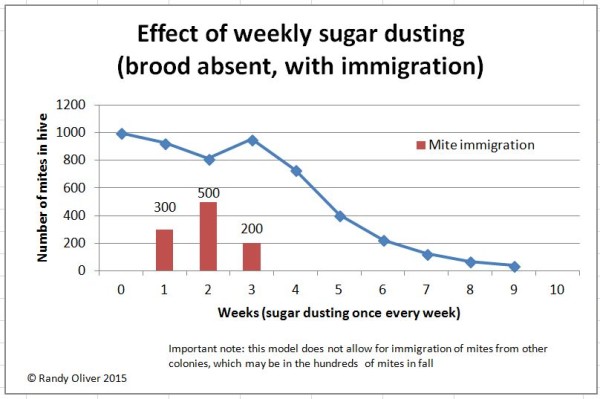Simulation of sugar dusting against varroa
Knowing the intrinsic rate of reproduction of the honey bee colony and of varroa, the proportion of mites that are phoretic at the time, and the efficacy of a powdered sugar dusting at removing those phoretic mites, one can create a spreadsheet that will calculate the estimated effect of repeated sugar dustings.
I’ve done so, and found that unless you dust regularly, and at frequent intervals (weekly during broodrearing season) that sugar dusting is not a very effective method of mite management.
I was recently asked by beekeeper Amanda Millar from Sussex to estimate the effect of weekly sugar dusting. To do so, I created an interactive spreadsheet, which you can download to play with: Dusting simulation spreadsheet
Here are a couple of sample simulations:


Beekeeper Justin Kay asked the following questions:
>Two questions:
1) Where did you get the assumption that 40% of the phoretic mites drop as
a result of the sugar dusting?
From my own data, by dusting colonies, and then killing all the remaining bees, and washing the remaining mites from them. Did not do many colonies, but range from thorough dusting was 40-60%. In my spreadsheet, you have the option of changing the efficacy if you have data to support.
>2) More of a comment – the spreadsheet doesn’t account for the theoretical
increase or decrease in the population of the colony itself, i.e. the “%
infestation” rather than the total number of mites per colony.
Yep. The “r” of varroa when brood is present is typically close to the r of the bee population–so the populations tend to build proportionally during the linear growth phase. That’s why I used total mite pop. rather than infestation rate, which will change with changes in the amount of worker or drone brood.
If you haven’t already done so, open up the Excel spreadsheet, and refer to the two tabs of field data from the two Amanda’s.
First look at Amanda Ellis’s data for both untreated and sugar dusted colonies over 11 months.
Then compare to that of Amanda Millar from the U.K., who recently sent me a nice data set from her own colonies (117 mite counts from 7 colonies) which were dusted on a regular basis. Her data (reprinted by permission) strongly support the model with its current values.
Of note is that in spring she increased the frequency of dusting to the range of every 2-6 days, which appears to have reduced the mite population despite the presence of brood. I’ve gotten conflicting data from other beekeepers who have tried high frequency dusting, but get the impression that it does help. I haven’t modeled at such frequency, but would expect it to have that effect.
The problem in the real world is that few beekeepers would ever maintain such a schedule of dusting. So although sugar dusting does indeed appear to have merit, its efficacy is severely limited when brood is present, and the necessary frequency of dusting for good mite control makes it unrealistic for practical application for any but the most diligent beekeepers.





